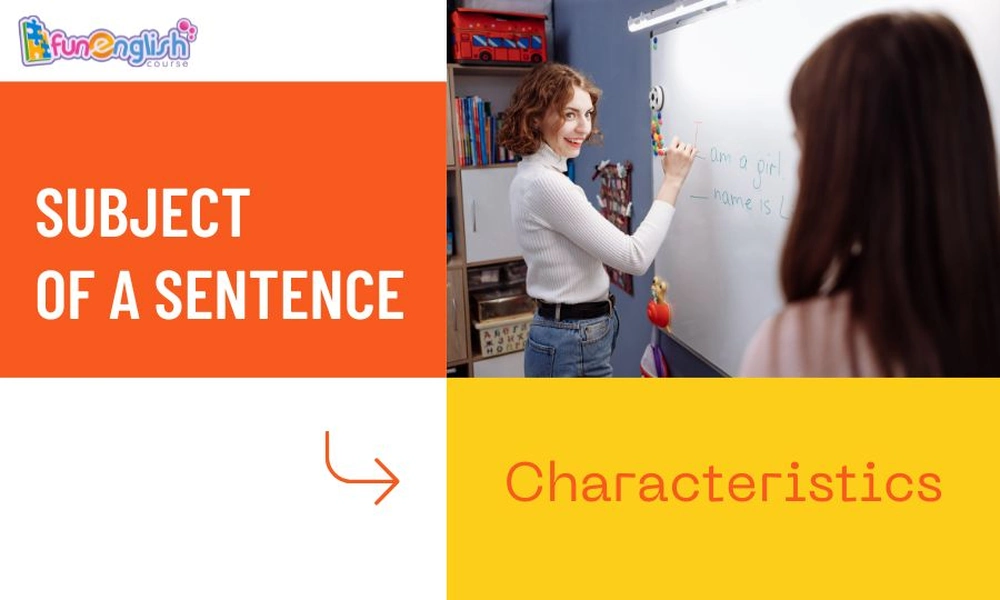The subject of a sentence is a fundamental element that serves as the backbone of language structure. It plays a pivotal role in shaping the meaning and tone of a sentence.
Thus, understanding the subject’s importance and its various forms is essential for effective communication. In this post, Fun English Course will explore the concept of the subject, its characteristics, and its significance in sentence construction.
Definition of the Subject and Why It Matters

So, what is subject in grammar?
“The subject of a sentence is the main noun or pronoun that performs the action or is being described in the sentence. More than that, it is what the sentence is primarily about and provides the focus of the message.”
Identifying the subject is crucial for comprehending the intended meaning of a sentence. Especially because it clarifies who or what is performing the action or experiencing a state of being. Thus, it ensures clear communication between the speaker and the listener.
Furthermore, the subject sets the tone and mood of the sentence. Different subjects can evoke various emotions. Therefore, you have to learn to choose the right subject to convey your message effectively.
Characteristics of the Subject

The subject of a sentence is the foundation upon which the rest of the sentence is built. Therefore, it dictates the verb form and influences the overall structure.
Here are the characteristics of the subject of a sentence:
Nouns and Pronouns
Subjects can be either nouns or pronouns. Nouns are names of people, places, objects, or concepts, while pronouns are words that replace nouns. Both serve as subjects and help to convey the message.
Example:
- The sun (noun) shines brightly.
- It (pronoun) shines brightly.
Placement in the Sentence
In most English sentences, the subject comes before the verb. Thus, it establishes the “who” or “what” of the sentence. More than that, the subject and the predicate of a sentence (the part of the sentence containing the verb) work together to convey the message clearly and concisely.
Example: Max (subject) loves to play the guitar.
Agreement with the Verb
Subject-verb agreement ensures grammatical accuracy in a sentence. A mismatch between the subject and the verb can lead to confusion and misinterpretation.
In other words, the subject and the verb must agree in number whether it is singular or plural.
Example:
- The cat (singular subject) purrs happily.
- The cats (plural subject) purr happily.
Identifying the Subject
 Here’s how to identify subject in a sentence!
Here’s how to identify subject in a sentence!
Simple Sentences: Straightforward Subjects
In simple sentences, identifying the subject is usually straightforward. The subject directly precedes the verb. So, it is easy to determine who or what is performing the action.
Example: She (subject) runs every morning.
Complex Sentences: Recognizing Subject Clauses
In complex sentences, subject clauses can be more challenging to identify. These are dependent clauses that act as subjects and require a careful analysis of the sentence structure.
Example: What he said (subject clause) surprised everyone.
Compound Sentences: Subjects in Compound Structures
In compound sentences, two or more subjects can be connected with a coordinating conjunction. Thus, understanding how these subjects work together is crucial to grasp the intended meaning.
Example: The dog barked, and the cat meowed. (Both “The dog” and “the cat” are subjects)
3 Types of Subjects in Sentences

There 3 types of subjects: explicit subjects, implicit or elliptical Subjects, and compound subjects. So, what are they?
1. Explicit Subjects
An explicit subject refers to a subject that is clearly stated or directly mentioned in a sentence. It is the noun or pronoun that performs the action or is being described. Moreover, it is usually found at the beginning of the sentence or within the subject position.
The explicit subject is straightforward and does not require any inference or guesswork to identify.
Example:
- The river (noun subject) flows calmly.
- They (pronoun subject) will arrive soon.
2. Implicit or Elliptical Subjects
However, sometimes, the subject is implicit or elliptical. Therefore, it requires the reader to infer the missing information from the context.
Example: “Bought some fruit yesterday.” (Implicit subject: “I” bought some fruits yesterday.)
3. Compound Subjects
Compound subjects consist of two or more nouns or pronouns connected by a coordinating conjunction. Furthermore, they work together as a unit to perform the action.
Example: Tom and Jerry (compound subject) love to chase each other.
Conclusion
The subject of a sentence is the basis of effective communication. It influences the structure, tone, and meaning of the sentence.
Identifying the subject correctly is a crucial structure for clear and coherent communication. Thus, our many programs in Fun English Course are focusing on structures to help you communicate better in English.
Want to learn more about the subject of a sentence? Join our English Conversation programs in Fun English Course!
